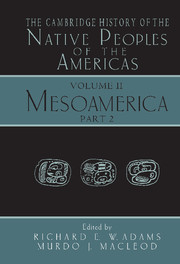Book contents
- Frontmatter
- 12 Mesoamerica Since the Spanish Invasion: an Overview
- 13 Legacies of Resistance, Adaptation, and Tenacity: History of the Native Peoples of Northwest Mexico
- 14 The Native Peoples of Northeastern Mexico
- 15 The Indigenous Peoples of Western Mexico from the Spanish Invasion to the Present
- 16 Native Peoples of Colonial Central Mexico
- 17 Native Peoples of Central Mexico Since Independence
- 18 Native Peoples of the Gulf Coast from the Colonial Period to The Present
- 19 The Indigenous Population of Oaxaca from the Sixteenth Century to the Present
- 20 The Lowland Mayas, from the Conquest to the Present
- 21 The Highland Maya
- Index to Part 2
- Map 12.1: A general map of Mesoamerica, showing major ancient, colonial, and modern population centers"
18 - Native Peoples of the Gulf Coast from the Colonial Period to The Present
Published online by Cambridge University Press: 28 March 2008
- Frontmatter
- 12 Mesoamerica Since the Spanish Invasion: an Overview
- 13 Legacies of Resistance, Adaptation, and Tenacity: History of the Native Peoples of Northwest Mexico
- 14 The Native Peoples of Northeastern Mexico
- 15 The Indigenous Peoples of Western Mexico from the Spanish Invasion to the Present
- 16 Native Peoples of Colonial Central Mexico
- 17 Native Peoples of Central Mexico Since Independence
- 18 Native Peoples of the Gulf Coast from the Colonial Period to The Present
- 19 The Indigenous Population of Oaxaca from the Sixteenth Century to the Present
- 20 The Lowland Mayas, from the Conquest to the Present
- 21 The Highland Maya
- Index to Part 2
- Map 12.1: A general map of Mesoamerica, showing major ancient, colonial, and modern population centers"
Summary
Since this chapter was written, several new studies have recently appeared, which include: Antonio Escobar Ohmstede, De cabeceras á pueblos-sujetos. Las continuidades y transformaciones de los pueblos indios de las Huastecas hidalguense y veracruzana, 1750–1853 (Ph.D. diss., El Colegio de México, 1994), and “Del gobierno indígena al Ayuntamiento constitucional en las Huastecas hidalguense y veracruzana, 1780–1853”; Mexican Studies-Estudios Mexicanos, vol. 12, no. 1 (1996); David Skerrit, “Tres culturas: un nuevo espacio regional (el caso de la colonia francesa de Jicaltepec, San Rafael),” in Odile Hoffman and Emilia Velázquez eds., Las llanuras costeras de Veracruz: la lenta construcción de regiones (Jalapa: ORSTOM-Universidad Veracruzana, 1994); David Buckles and Jacques Chevalier, A Land Without Gods: Process Theory, Maldevelopment and the Mexican Nahuas (London: Zed Books, 1995); and Victoria Chenaut, Aquellos que Vuelan: Los Totonacas en el Siglo XIX (Mexico, 1995). I wish to thank Heather Fowler-Salamini for her valuable suggestions and comments on this chapter.
Perhaps one of the most memorable figures to emerge from Bernal Díaz del Castillo’s History of the Conquest of New Spain (London, 1972) is the so-called Fat Chief from Cempoala, one of the first indigenous lords to meet with Hernando Cortez. One might be forgiven for assuming that such an encounter and its impact on the native peoples who inhabited and inhabit the region of the Gulf Coast of Mexico have stimulated considerable historical research. Unfortunately this has not been the case, and the rich literature on the pre-conquest societies of the Gulf Coast has yet to be matched by that for the post-conquest period.
Keywords
- Type
- Chapter
- Information
- The Cambridge History of the Native Peoples of the Americas , pp. 274 - 301Publisher: Cambridge University PressPrint publication year: 2000
- 3
- Cited by

